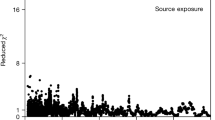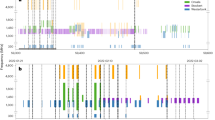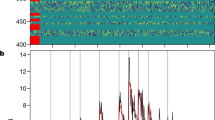Abstract
Fast radio bursts (FRBs) are extragalactic transient flashes of radio waves with typical durations of milliseconds. FRBs have been shown, however, to present a wide range of timescales: some show sub-microsecond sub-bursts while others last up to a few seconds. Probing FRBs on a range of timescales is crucial for understanding their emission physics, how to detect them effectively and how to maximize their utility as astrophysical probes. FRB 20121102A is the first known repeating FRB source. Here we show that FRB 20121102A produces isolated microsecond-duration bursts with durations less than one-tenth the duration of other currently known FRBs. The polarimetric properties of these microsecond-duration bursts resemble those of the longer-lasting bursts, suggesting a common emission mechanism producing FRBs with durations spanning three orders of magnitude. In detecting and characterizing these microsecond-duration bursts, we show that there exists a population of ultra-fast radio bursts that current wide-field FRB searches are missing due to insufficient time resolution. These results indicate that FRBs occur more frequently and with greater diversity than initially thought. This could also influence our understanding of energy, wait time and burst rate distributions.
This is a preview of subscription content, access via your institution
Access options
Access Nature and 54 other Nature Portfolio journals
Get Nature+, our best-value online-access subscription
$29.99 / 30 days
cancel any time
Subscribe to this journal
Receive 12 digital issues and online access to articles
$119.00 per year
only $9.92 per issue
Buy this article
- Purchase on Springer Link
- Instant access to full article PDF
Prices may be subject to local taxes which are calculated during checkout




Similar content being viewed by others
Data availability
The data that support the plots within this paper and other findings of this study are available from https://doi.org/10.5281/zenodo.8112803 or from the corresponding author upon reasonable request. The voltage data are available through the Breakthrough Initiatives Open Data Portal, https://breakthroughinitiatives.org/opendatasearch, and are explained in http://seti.berkeley.edu:8000/frb-data/.
Code availability
The pulsar package dspsr is available at https://dspsr.sourceforge.net/ and a modified version of dspsr, bl-dspsr, that can read voltage data from the Breakthrough Listen backend is available at https://github.com/UCBerkeleySETI/bl-dspsr. Code to splice and extract voltage data is available at https://github.com/greghell/extractor. FETCH can be found at https://github.com/devanshkv/fetch. The PRESTO suite of tools is available at https://github.com/scottransom/presto.
References
Petroff, E., Hessels, J. W. T. & Lorimer, D. R. Fast radio bursts. Astron. & Astrophys. Rev. 27, 4 (2019).
Petroff, E., Hessels, J. W. T. & Lorimer, D. R. Fast radio bursts at the dawn of the 2020s. Astron. & Astrophys. Rev. 30, 2 (2022).
Pleunis, Z. et al. Fast radio burst morphology in the first CHIME/FRB catalog. Astrophys. J. 923, 1 (2021).
Connor, L., Miller, M. C. & Gardenier, D. W. Beaming as an explanation of the repetition/width relation in FRBs. Mon. Not. R. Astron. Soc. 497, 3076–3082 (2020).
CHIME/FRB Collaboration. CHIME/FRB discovery of 25 repeating fast radio burst sources. Astrophys. J. 947, 83 (2023).
Marcote, B. et al. The repeating fast radio burst FRB 121102 as seen on milliarcsecond angular scales. Astrophys. J. Lett. 834, L8 (2017).
Marcote, B. et al. A repeating fast radio burst source localized to a nearby spiral galaxy. Nature 577, 190–194 (2020).
Kirsten, F. et al. A repeating fast radio burst source in a globular cluster. Nature 602, 585–589 (2022).
Nimmo, K. et al. Milliarcsecond localization of the repeating FRB 20201124A. Astrophys. J. Lett. 927, L3 (2022).
Ocker, S. K. et al. Scattering variability detected from the circumsource medium of FRB 20190520B. Mon. Not. R. Astron. Soc. 519, 821–830 (2023).
Michilli, D. et al. An extreme magneto-ionic environment associated with the fast radio burst source FRB 121102. Nature 553, 182–185 (2018).
Hilmarsson, G. H. et al. Rotation measure evolution of the repeating fast radio burst source FRB 121102. Astrophys. J. Lett. 908, L10 (2021).
Spitler, L. G. et al. Fast radio burst discovered in the arecibo pulsar ALFA survey. Astrophys. J. 790, 101 (2014).
Hessels, J. W. T. et al. FRB 121102 bursts show complex time-frequency structure. Astrophys. J. Lett. 876, L23 (2019).
Josephy, A. et al. CHIME/FRB detection of the original repeating fast radio burst source FRB 121102. Astrophys. J. Lett. 882, L18 (2019).
Wang, P. et al. FRB 20121102A is active again with significantly smaller DM as revealed by FAST. The Astronomer’s Telegram 15619, 1 (2022).
CHIME/FRB Collaboration. Periodic activity from a fast radio burst source. Nature 582, 351–355 (2020).
Pleunis, Z. et al. LOFAR detection of 110-188 MHz emission and frequency-dependent activity from FRB 20180916B. Astrophys. J. Lett. 911, L3 (2021).
Gajjar, V. et al. Highest frequency detection of FRB 121102 at 4-8 GHz using the breakthrough Listen Digital Backend at the Green Bank telescope. Astrophys. J. 863, 2 (2018).
MAGIC Collaboration. Constraining very-high-energy and optical emission from FRB 121102 with the MAGIC telescopes. Mon. Not. R. Astron. Soc. 481, 2479–2486 (2018).
Hiramatsu, D. et al. Limits on simultaneous and delayed optical emission from well-localized fast radio bursts. Astrophys. J. Lett. 947, L28 (2023).
Spitler, L. G. et al. A repeating fast radio burst. Nature 531, 202–205 (2016).
Chatterjee, S. et al. A direct localization of a fast radio burst and its host. Nature 541, 58–61 (2017).
Lorimer, D. R., Bailes, M., McLaughlin, M. A., Narkevic, D. J. & Crawford, F. A bright millisecond radio burst of extragalactic origin. Science 318, 777 (2007).
Tendulkar, S. P. et al. The host galaxy and redshift of the repeating fast radio burst FRB 121102. Astrophys. J. Lett. 834, L7 (2017).
Bassa, C. G. et al. FRB 121102 is coincident with a star-forming region in its host galaxy. Astrophys. J. Lett. 843, L8 (2017).
Michilli, D. et al. Single-pulse classifier for the LOFAR Tied-Array All-sky Survey. Mon. Not. R. Astron. Soc. 480, 3457–3467 (2018).
Plavin, A. et al. FRB 121102: drastic changes in the burst polarization contrasts with the stability of the persistent emission. Mon. Not. R. Astron. Soc. 511, 6033–6041 (2022).
Feng, Y. et al. A highly depolarized burst from FRB 20121102A with significantly smaller RM as revealed by FAST. The Astronomer’s Telegram 15980, 1 (2023).
Cho, H. et al. Spectropolarimetric analysis of FRB 181112 at microsecond resolution: implications for fast radio burst emission mechanism. Astrophys. J. Lett. 891, L38 (2020).
Farah, W. et al. FRB microstructure revealed by the real-time detection of FRB170827. Mon. Not. R. Astron. Soc. 478, 1209–1217 (2018).
Nimmo, K. et al. Highly polarized microstructure from the repeating FRB 20180916B. Nat. Astron. 5, 594–603 (2021).
Nimmo, K. et al. Burst timescales and luminosities as links between young pulsars and fast radio bursts. Nat. Astron. 6, 393–401 (2022).
Zhang, Y. G. et al. Fast radio burst 121102 pulse detection and periodicity: a machine learning approach. Astrophys. J. 866, 149 (2018).
MacMahon, D. H. E. et al. The breakthrough Listen Search for Intelligent Life: a wideband data recorder system for the Robert C. Byrd Green Bank Telescope. Publ. Astron. Soc. Pac. 130, 044502 (2018).
van Straten, W. & Bailes, M. DSPSR: digital signal processing software for pulsar astronomy. Pubs. Astron. Soc. Australia 28, 1–14 (2011).
Lorimer, D. R. SIGPROC: Pulsar Signal Processing Programs. Astrophysics Source Code Library, record ascl:1107.016 (2011), https://sigproc.sourceforge.net/
Ransom, S. M. New search techniques for binary pulsars. PhD thesis, Harvard Univ. (2001).
Cordes, J. M. & McLaughlin, M. A. Searches for fast radio transients. Astrophys. J. 596, 1142–1154 (2003).
Agarwal, D., Aggarwal, K., Burke-Spolaor, S., Lorimer, D. R. & Garver-Daniels, N. FETCH: a deep-learning based classifier for fast transient classification. Mon. Not. R. Astron. Soc. 497, 1661–1674 (2020).
Hankins, T. H., Kern, J. S., Weatherall, J. C. & Eilek, J. A. Nanosecond radio bursts from strong plasma turbulence in the Crab pulsar. Nature 422, 141–143 (2003).
Hankins, T. H. & Eilek, J. A. Radio emission signatures in the Crab pulsar. Astrophys. J. 670, 693–701 (2007).
Jessner, A. et al. Giant pulses with nanosecond time resolution detected from the Crab pulsar at 8.5 and 15.1 GHz. Astron. Astrophys. 524, A60 (2010).
Faber, J. T. et al. Re-analysis of Breakthrough Listen observations of FRB 121102: polarization properties of eight new spectrally narrow bursts. RNAAS 5, 17 (2021).
Everett, J. E. & Weisberg, J. M. Emission beam geometry of selected pulsars derived from average pulse polarization data. Astrophys. J. 553, 341–357 (2001).
Lorimer, D. R. & Kramer, M. Handbook of Pulsar Astronomy (Cambridge Univ. Press, 2012).
Tendulkar, S. P. et al. The 60 pc environment of FRB 20180916B. Astrophys. J. Lett. 908, L12 (2021).
CHIME/FRB Collaboration. CHIME/FRB discovery of eight new repeating fast radio burst sources. Astrophys. J. Lett. 885, L24 (2019).
Nimmo, K. et al. A burst storm from the repeating FRB 20200120E in an M81 globular cluster. Mon. Not. R. Astron. Soc. 520, 2281–2305 (2023).
CHIME/FRB Collaboration. The first CHIME/FRB fast radio burst catalog. Astrophys. J. Suppl. Ser. 257, 59 (2021).
Feng, Y. et al. Frequency-dependent polarization of repeating fast radio bursts—implications for their origin. Science 375, 1266–1270 (2022).
Beniamini, P., Kumar, P. & Narayan, R. Faraday depolarization and induced circular polarization by multipath propagation with application to FRBs. Mon. Not. R. Astron. Soc. 510, 4654–4668 (2022).
Feng, Y. et al. Circular polarization in two active repeating fast radio bursts. Sci. Bull. 67, 2398–2401 (2022).
Zhang, Y.-K. et al. FAST observations of FRB 20220912A: burst properties and polarization characteristics. Preprint at arXiv:2304.14665 (2023).
Feng, Y. et al. An extreme active repeating fast radio burst in a clean environment. Preprint at arXiv:2304.14671 (2023).
Beniamini, P. & Kumar, P. What does FRB light-curve variability tell us about the emission mechanism? Mon. Not. R. Astron. Soc. 498, 651–664 (2020).
Worden, S. P. et al. Breakthrough Listen - A new search for life in the universe. Acta Astronaut. 139, 98–101 (2017).
Lebofsky, M. et al. The Breakthrough Listen search for intelligent life: public data, formats, reduction, and archiving. Publ. Astron. Soc. Pac. 131, 124505 (2019).
Hewitt, D. M. et al. Arecibo observations of a burst storm from FRB 20121102A in 2016. Mon. Not. R. Astron. Soc. 515, 3577–3596 (2022).
Pennucci, T. T. et al. Elementary wideband timing of radio pulsars. Astrophys. J. 790, 93 (2014).
Pennucci, T. T. Frequency-dependent template profiles for high-precision pulsar timing. Astrophys. J. 871, 34 (2019).
Cordes, J. M. & Lazio, T. J. W. NE2001.I. A New Model for the Galactic Distribution of Free Electrons and its Fluctuations. Preprint at astro-ph/0207156 (2002).
Scheuer, P. A. G. Amplitude variations in pulsed radio sources. Nature 218, 920–922 (1968).
Lee, L. C. & Jokipii, J. R. Strong scintillations in astrophysics. II. A theory of temporal broadening of pulses. Astrophys. J. 201, 532–543 (1975).
Ikebe, S. et al. Detection of a bright burst from the repeating fast radio burst 20201124A at 2 GHz. PASJ 75, 199–207 (2023).
Kirsten, F. et al. Connecting repeating and non-repeating fast radio bursts via their energy distributions. Preprint at arXiv:2306.15505 (2023).
van Straten, W., Manchester, R. N., Johnston, S. & Reynolds, J. E. PSRCHIVE and PSRFITS: definition of the Stokes parameters and instrumental basis conventions. Pubs. Astron. Soc. Australia 27, 104–119 (2010).
Mckinven, R. et al. Polarization pipeline for fast radio bursts detected by CHIME/FRB. Astrophys. J. 920, 138 (2021).
Kirsten, F. et al. Detection of two bright radio bursts from magnetar SGR 1935 + 2154. Nat. Astron. 5, 414–422 (2021).
Acknowledgements
We would like to thank the Breakthrough Listen project for keeping the raw baseband data from its observations and making them publicly available. Breakthrough Listen is funded by the Breakthrough Initiatives (https://breakthroughinitiatives.org/). We thank J. Weisberg for useful discussions about radio astronomy and polarimetry. A. D. Seymour is thanked for tips regarding the GBT BL data. Research by the AstroFlash group at University of Amsterdam, ASTRON and JIVE is supported in part by an NWO Vici grant (Principal investigator, J.W.T.H.; VI.C.192.045). K.N. is an MIT Kavli Fellow.
Author information
Authors and Affiliations
Contributions
M.P.S. led the burst search, data analysis, and made the figures and tables. He wrote the majority of the manuscript. K.N. made substantial contributions to the writing and provided guidance on the data analysis. J.W.T.H. supervised the work, guided the overall approach and made substantial contributions to the writing. All co-authors provided input on the scientific interpretation.
Corresponding author
Ethics declarations
Competing interests
The authors declare no competing interests.
Peer review
Peer review information
Nature Astronomy thanks Yi Feng and the other, anonymous, reviewer(s) for their contribution to the peer review of this work.
Additional information
Publisher’s note Springer Nature remains neutral with regard to jurisdictional claims in published maps and institutional affiliations.
Extended data
Extended Data Fig. 1 Peak S/N of the \(\mathbf{341.}\bar{\mathbf{3}}\)-ns profiles of bursts B30 and B43, as a function of DM.
The bursts were first coherently dedispersed to a DM of 560.1 pc cm−3 and thereafter incoherently dedispersed to a range of nearby trial DMs with a step size of 0.0002 pc cm−3. The peak S/N is determined for every DM and is shown with grey circles for B30 and grey pentagons for B43. For visual purposes, moving averages are shown with solid and dashed black lines for B30 and B43, respectively. A Lorentzian distribution is fit (solid green line) to the individual data points close to the peak of the profile of B30 and the best DM, 560.105 pc cm−3, is determined to be the centre of the fitted distribution (solid vertical line). Similarly, all the data points of B43 are fitted with a Gaussian distribution (solid orange line), which peaks at a DM of 560.308 pc cm−3 (dashed vertical line).
Extended Data Fig. 2 Dispersion measure (DM) comparison for the two brightest ultra-FRBs.
Burst B30 (panels a, b, c and d) and burst B43 (panels e, f, g and h) are coherently dedispersed to a DM of 560.105 pc cm−3 (left column) and 560.308 pc cm−3 (right column). The dynamic spectra (panels b, d, f and h) have a time resolution of \(341.\bar{3}\) ns and a frequency resolution of 2.9296875 MHz. The dashed red lines indicate the frequency range that was averaged over to create the burst profiles, which also have a time resolution of \(341.\bar{3}\) ns (panels a, c, e and g). Using a DM of 560.308 pc cm−3 slightly increases the peak S/N of burst B43 and the width of burst B43 decreases by about 2 μs. However, using a DM of 560.308 pc cm−3, burst B30 is clearly over-dedispersed (panel d).
Extended Data Fig. 3 Detection duration as a function of time.
Every FRB is found in multiple subbands and/or trial boxcar widths (Methods). Both the colour shading and the size of the data points correspond to the S/N of the burst detection, with larger/darker dots indicating a higher S/N. Colours indicate whether the bursts have been found before by Gajjar et al.19 and Zhang et al.34.
Extended Data Fig. 4 Spectral extent as a function of time.
Every FRB is found in multiple subbands and/or trial boxcar widths (Methods). For every burst detection we plot a rectangle showing the frequency range of the corresponding subband and a 2-second time interval around the burst arrival time. Every rectangle has the same transparency and the colours become darker as multiple patches are plotted on top of each other. Colours indicate whether the bursts have been found before by Gajjar et al.19 and Zhang et al.34.
Extended Data Fig. 5 The transient phase space for coherent radio emission.
The transient duration (width times the central frequency of the burst) and the isotropic-equivalent spectral luminosity of the 8 ultra-FRBs shown in Fig. 1 are plotted as red stars. A selection of published localized repeating FRBs are plotted as crosses. Radio bursts from the Galactic magnetar SGR 1935+2154 are shown as purple plusses. The pulsar and Rotating RAdio Transient (RRAT) population are shown as pink and magenta circles, respectively. Giant radio pulses (GRPs) and ‘nanoshots’ of the Crab pulsar are shown as orange and yellow circles, respectively. The diagonal grey lines represent levels of constant brightness temperature. The three data points from FRB 20200120E that have a brightness temperature of > 1040 K are from bursts that show short temporal structure within a broader burst envelope33. Based on a figure presented in Nimmo et al.33 (see references therein).
Supplementary information
Supplementary Information
Supplementary Tables 1–3.
Supplementary Data 1
Computer-readable version of Supplementary Table 3. Table encapsulates the search strategy: Dispersion measure (DM) range, DM step-size, number of channels, number of ‘subbands’, time resolution, bandwidth and frequency range.
Rights and permissions
Springer Nature or its licensor (e.g. a society or other partner) holds exclusive rights to this article under a publishing agreement with the author(s) or other rightsholder(s); author self-archiving of the accepted manuscript version of this article is solely governed by the terms of such publishing agreement and applicable law.
About this article
Cite this article
Snelders, M.P., Nimmo, K., Hessels, J.W.T. et al. Detection of ultra-fast radio bursts from FRB 20121102A. Nat Astron 7, 1486–1496 (2023). https://doi.org/10.1038/s41550-023-02101-x
Received:
Accepted:
Published:
Issue Date:
DOI: https://doi.org/10.1038/s41550-023-02101-x



